
Installation view, Friends in Love and War – L’Éloge des meilleur·es ennemi·es, Ikon Gallery, 2024. Image courtesy Ikon. Photo: David Rowan.
Ikon Gallery, Birmingham
2 October 2024 – 23 February 2025
by DAVID TRIGG
“There is nothing on this Earth more to be prized than true friendship,” wrote Thomas Aquinas, who believed that friends are the source of life’s greatest pleasures. Characterised by mutual affection, trust and esteem, friendship is an integral aspect of the human condition. For Aristotle, the phenomenon was fundamental to his conception of the good life, while Jacques Derrida argued that such relationships can exist only in relation to their antithesis: enmity. The many faces of friendship come under the spotlight in this ambitious group exhibition, which is itself the product of a friendly collaboration between Ikon Gallery, Lyon’s Museum of Contemporary Art (macLYON) and the British Council Collection. Curated by longstanding friends Melanie Pocock and Marilou Laneuville, it weaves together an intriguing tapestry of narratives that are as rich and complex as its subject.

Markéta Luskačová,installation view, Friends in Love and War – L’Éloge des meilleur·es ennemi·es, Ikon Gallery, 2024. Image courtesy Ikon. Photo: David Rowan.
Many friendships are forged at school, where children learn to negotiate, compromise and cooperate with one another. Markéta Luskačová’s delightful black-and-white photographs of schoolchildren at play from 1988 were made for a Channel 4 series that followed the lives of babies born in 1982 until they turned 18 in the year 2000. One candid shot shows four girls grasping each other’s cardigans as they dart across a playground; in another, two small boys find amusement in stretching jumpers over their heads. A grittier print records several lads consoling a peer while another scowls, his clenched fist raised. Whether Luskačová captured the aftermath of a scrap or the beginnings of another is unclear; friendships at this age are fickle, but they can also form bonds that last a lifetime.
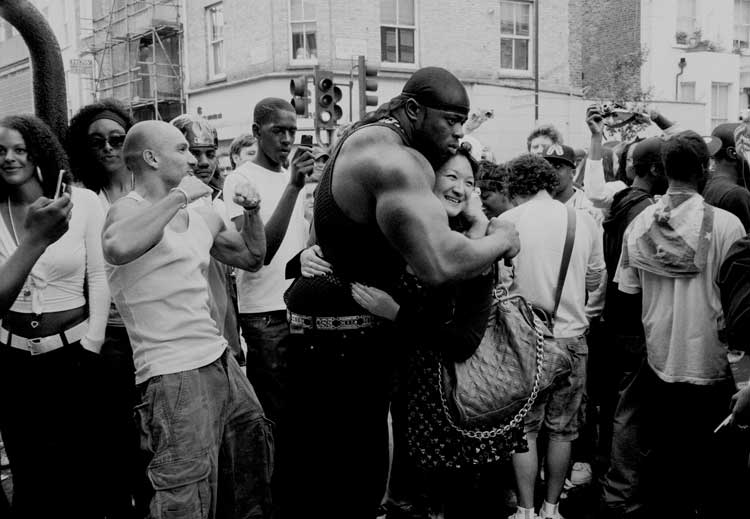
Pogus Caesar, See Oat, London, 2008. Series Schwarz Flaneur, started in 1983. Black-and-white photograph, 35mm. 34 x 44 cm Courtesy of the artist and OOM Gallery Archive.
Unguarded moments are similarly the heartbeat of Pogus Caesar’s arresting photographs. Ten prints from his Schwarz Flaneur series (1983-ongoing) are displayed here, in which we see Birmingham dinner ladies sharing a joke, lovers embracing at Lake Como, Italy, and best friends hanging out in Cape Town, South Africa. In See Dat, London (2008), professional wrestler Tiny Iron flexes his impossibly large muscles as he hugs a petite woman amid revellers at the Notting Hill carnival. Caught in the moment, it is impossible to know the extent of this couple’s relationship, though the image radiates conviviality. Caesar’s photographs, like Luskačová’s, are authentic, uncynical and resolutely human.
This is not, however, an exhibition dominated by amiable relationships. Loneliness is a significant theme, as addressed by Sonia Boyce’s Pillowcase (1990), a playful painting depicting newspaper classified ads placed by individuals seeking friendship and romance. Now that dating apps have become the norm, such personal ads appear archaic, hailing from a time when loneliness was perhaps more visible. Certainly, a lack of friendship is not always apparent and hidden loneliness is suggested by Patrick Caulfield’s vibrant screenprint I’ve Only the Friendship of Hotel Rooms (1973). Elegant in its graphic simplicity, this rendering of a small bedside lamp is one of 22 prints made to illustrate the poems of Jules Laforgue, though in light of recent events in Britain it brings to mind the experience of those who, having sought asylum, find themselves in temporary accommodation, isolated and alone.
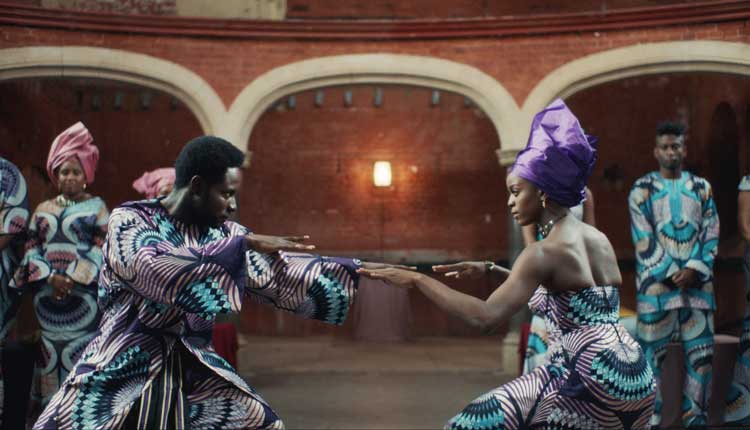
Hetain Patel, Don't Look at The Finger, 2017. Single channel HD video, colour and stereo sound. Duration: 16 minutes 9 seconds. © Hetain Patel. Courtesy of British Council Collection.
In friendships, the line between love and conflict is often blurred. Hetain Patel’s enthralling video Don’t Look at the Finger (2017), begins with what appears to be a West-African wedding ceremony that unexpectedly transforms into a dramatic, intricately choreographed kung fu battle. The couple twist and turn, their energetic movements becoming increasingly intense as the drama unfolds. A ritualistic duel, or perhaps an esoteric sporting event, appears to be underway in Marie-Anita Gaube’s large-scale painting La Lutte Amoureuse (2016). In a dreamlike landscape, two hunched figures face-off, ready to wrestle, though their bodies seem to be dissolving into their tropical surroundings. The surreal and fragmented diptych neatly embodies the dualities suggested by the exhibition’s title, reminding us that even the best of friendships can sometimes rupture.
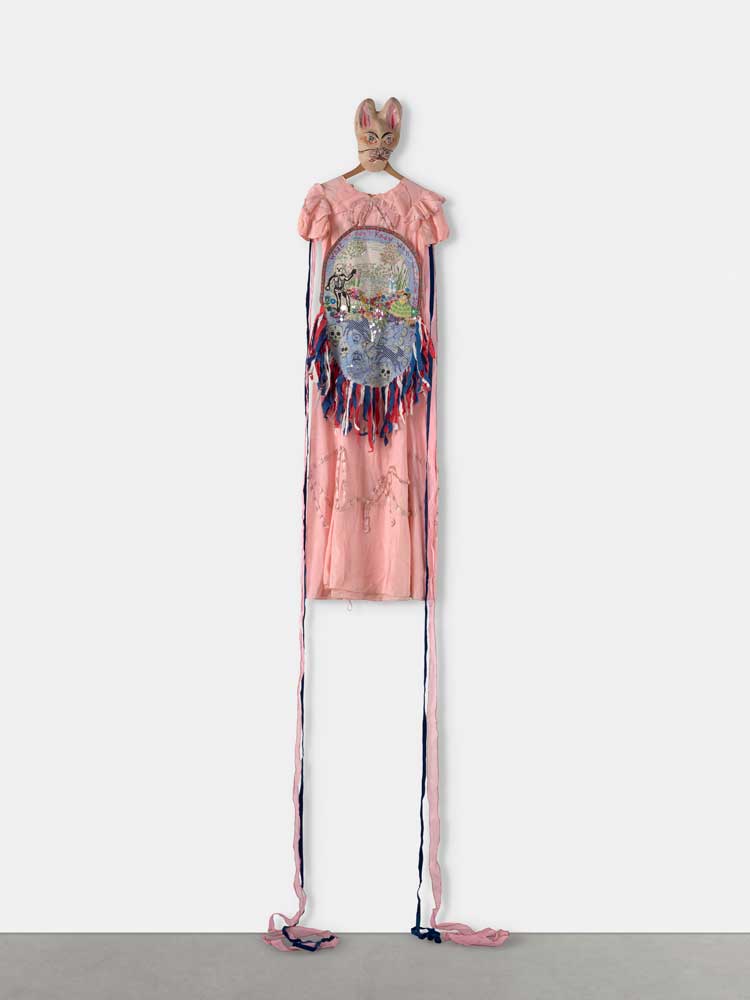
Delaine Le Bas, What We Don't know Won't Hurt Us? (Self Portrait), 2006 18. Mixed media sculpture, 293 x 54 cm. © British Council Collection. Photo: Alexander Christie, Courtesy of the artist.
The death of a friend can be extremely painful, especially if they are also a spouse. Delaine Le Bas lost her husband suddenly in 2017, and her grief is addressed in What We Don’t Know Won’t Hurt Us? (Self-Portrait) (2006-18). This pink dress, topped with a rabbit mask and embroidered with images of nature and skulls, conveys strong ecological overtones; hung high on the wall, it seems as to be ascending from the depths towards a more hopeful future.
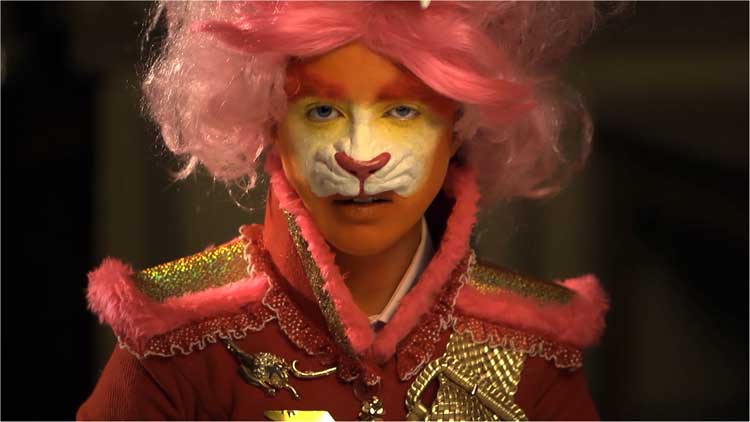
Rachel Maclean, The Lion and The Unicorn, 2012. Single channel HD video, colour and sound, 11 minutes 30 seconds. © Rachel Maclean, 2012, commissioned by The Edinburgh Printmakers. Courtesy of British Council Collection.
As Pocock notes in the catalogue that accompanies the exhibition, there has been a “friendly enmity” between France and England for centuries, exacerbated most recently by the fallout from Brexit. This notion of “best enemies” is, of course, not limited to the rifts between our island nation and mainland Europe. Rachel Maclean satirises the discourse surrounding the 2014 referendum on Scottish independence in her high-camp video The Lion and the Unicorn (2014), where she assumes the roles of English lion and Scottish unicorn (as per the UK coat of arms) and lip-syncs to the recorded words of David Cameron and the late Alex Salmond. A witty and darkly comic consideration of alliance and opposition, Maclean’s exploration of national identity sees the two protagonists squabble over the future of the United Kingdom as they quaff North-sea oil and munch on an indulgent union jack cake.
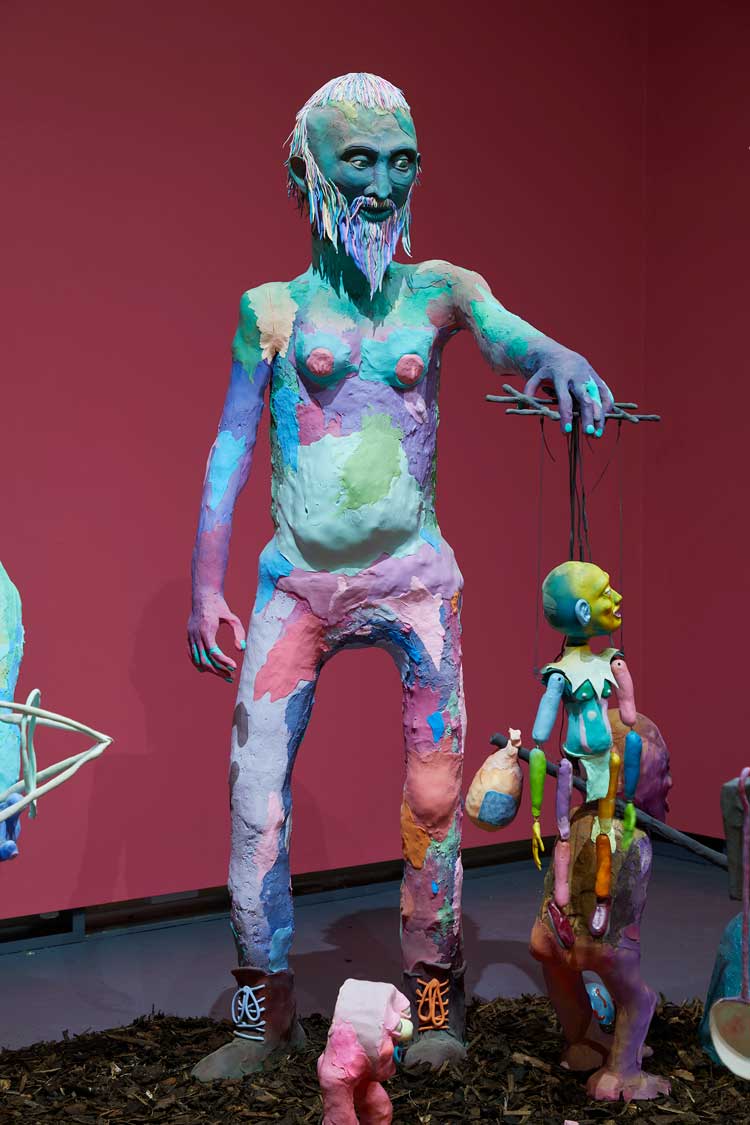
Luke Routledge, Strangelets, 2024. Mixed media. Variable dimensions. Courtesy of the artist.
Whereas Maclean’s characters wouldn’t look amiss in panto, Luke Routledge’s motley collection of absurd sculptural figures appear to have fallen from a fairytale. Inhabiting a bizarre, fictional universe, these colourful beings, known collectively as Strangelets (2024), have congregated around a bard who sits strumming a lute. One takes the form of a chimney stack, while another is dressed as a jester. There is the suggestion of camaraderie but, curiously, none of the otherworldly beings are interacting. Imagination and fantasy similarly run wild in Fabien Verschaere’s Seven Days Hotel (2007), an ambitious series of 60 drawings that tell the story of a sick child adventuring with a princess. Recalling medieval illuminated manuscripts, the work draws on Verschaere’s autobiography: he spent long periods in hospital as a child and, in his loneliness, invented many imaginary companions.

Tereza Buskova, Clipping the Church, 2016. Video, colour, sound, 8 minutes 14 seconds. Courtesy of the artist.
One of the show’s most poignant works is Tereza Bušková’s Clipping the Church (2016), a video in which the Birmingham-based Czech artist recreates an ancient English custom that involves a church congregation holding hands in a ring around their building and singing hymns and saying prayers. The virtually forgotten tradition was a way for Christians to show their love and appreciation for their church family and local community. Mixing elements of harvest festivals, Bohemian weddings and other folk traditions, Bušková orchestrated a procession, which saw 200 people from Birmingham’s Erdington district parade through the streets in traditional costume. The performance culminated in a literal embrace of the local church of St Barnabas. Bušková’s film points to the importance of friendship within communities of faith, where it helps foster a sense of identity and belonging.
“Could a commitment to friendship help us move beyond the social and political impasses we find ourselves in today?” asks Pocock. It is, perhaps, a leading question, but friendship, for all its benefits, remains difficult to define. Indeed, how such relationships are formed and sustained can often elude understanding. What is clear, however, is that this exhibition testifies to the abiding friendship of two cities. Lyon and Birmingham were twinned in 1951 as part of the effort to reconstruct relations between European countries after the divisions of the second world war. Reflecting the intricacies of personal and political friendships, Friends in Love and War is exemplary in demonstrating how regional capitals and cultural organisations can forge new ways of cooperating and collaborating in a post-Brexit landscape.